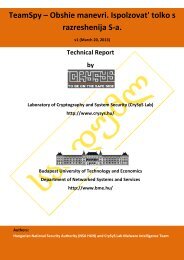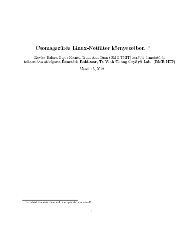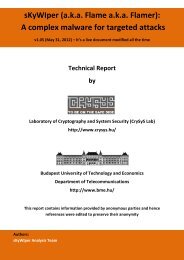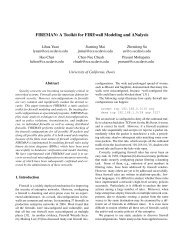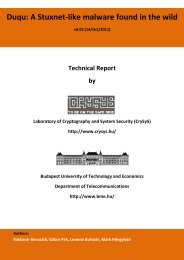Create successful ePaper yourself
Turn your PDF publications into a flip-book with our unique Google optimized e-Paper software.
2.6. Analysis of the group based approach<br />
the tags use their identifiers in the protocol) and from the rest of the tags in the system. This<br />
means that each member of the compromised group forms an anonymity set of size 1, and the<br />
remaining tags form another anonymity set. In general, when more tags are compromised, we can<br />
observe that the partitioning depends on the number C of the compromised groups, where a group<br />
is compromised if at least one tag that belongs to that group is compromised. More precisely,<br />
when C groups are compromised, we get nC anonymity sets of size 1 and an anonymity set of size<br />
n(γ − C), where γ is the number of groups and n = N/γ is the size of a group. This results in the<br />
following expression for the level R of the privacy according to the metric (2.18):<br />
R = 1<br />
N 2<br />
( 2<br />
nC + (n(γ − C)) )<br />
(2.19)<br />
If tags are compromised randomly, then C, and hence, R are random variables, and the level of<br />
privacy provided by the system is characterized by the expected value of R. In order to compute<br />
that, we must compute the expected value of C and that of C 2 . This can be done as follows: let<br />
us denote by Ai the event that at least one tag from the i-th group is compromised, and let IAi<br />
be Ai’s indicator function. The probability of Ai can be calculated as follows:<br />
(<br />
N − n<br />
)<br />
P (Ai) = 1 −<br />
c<br />
(<br />
N<br />
c<br />
) = (2.20)<br />
c−1 ∏<br />
(<br />
= 1 − 1 − n<br />
)<br />
N − j<br />
(2.21)<br />
j=0<br />
The expected value of C is the expected value of the sum of the indicator functions:<br />
E [C] = E<br />
[ γ∑<br />
i=1<br />
IAi<br />
]<br />
j=0<br />
=<br />
γ∑<br />
P (Ai) = (2.22)<br />
i=1<br />
⎛<br />
c−1 ∏<br />
(<br />
= γ ⎝1 − 1 − n<br />
)<br />
N − j<br />
⎞<br />
⎠ (2.23)<br />
Similarly, the second moment of C can be computed as follows:<br />
= E<br />
[ γ∑<br />
i=1<br />
E [ C 2] = E<br />
IAi<br />
[ γ∑<br />
] ⎡<br />
+ E ⎣ ∑<br />
i̸=j<br />
i=1<br />
IAi<br />
IAi∩Aj<br />
] 2<br />
⎤<br />
= (2.24)<br />
⎦ = (2.25)<br />
= E [C] + ( γ 2 − γ ) P (Ai ∩ Aj) (2.26)<br />
Finally, probability P (Ai ∩ Aj) can be computed in the following way:<br />
P (Ai ∩ Aj) = (2.27)<br />
= 1 − P ( ) ( )<br />
Ai ∩ Aj − 2P Ai ∩ Aj<br />
(2.28)<br />
25



